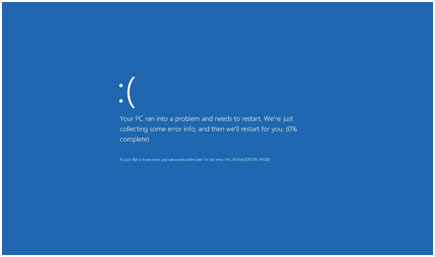What is BSOD?
BSOD stands out for the “Blue Screen of Death”, officially called the stop screen or stop error. It is the notorious, most undesirable generic set of error messages, that Windows computers display after a severe system crash.
A Blue Screen suggests that Windows can’t proceed, so after presenting the error message, Windows will execute some behind curtain housecleaning and restart. It features no warning and unfortunately, there’s no possibility to save your work (which you were up to), so a Blue Screen often involves losing data.
BSOD errors connect to system hardware, temperature, timing, sources, corrupt windows registries or viruses. The BSOD error screen serves as a sharp to prevent more computer system damage. A BSOD ices up Windows and also needs that the system is rebooted in order to continue to run.
Why Called Blue Screen of Death?
This term gets its name due to the fact that these essential messages were shown on a blue screen. Second of all, A BSOD doesn’t always suggest a “dead” computer, however, it does indicate a couple of things for sure.
For one, it implies everything has to stop, at the very least as for the operating system is concerned. You can’t “close” the error and go save your data, or reset your computer the correct way– it’s throughout, at least for the moment. This is where the correct term stoperror comes from.
Some BSODs appear during the Windows startup process, suggesting you’ll never ever get past it until you solve the issue. Others happen at various times throughout your use of your computer, therefore, tend to be easier to resolve.
Chronology of Blue Screen of Death
BSODs have been around since the early days of Windows and were much more common back then. From Windows 95 to Windows 7, the Blue Screen of Death didn’t transform much.

A dark blue background with a silver message. Lots and also great deals of unhelpful information on the display is no doubt a big factor the BSOD obtained such a well-known rap.
Beginning with Windows 8, it reduced the number of details and also put a large sad face emoji on the screen. It additionally places a QR code on display so individuals can search for the cause of the blue screen with their smartphones.

In Windows 10, the Blue Screen of Death color went from dark to light blue, and also, rather than a number of lines of mainly unhelpful information, there’s currently a standard explanation of what is happening together with the recommendation to “search online later” for the detailed stop code.
Reasons Behind Blue Screen of Death
Blue screens are typically caused by troubles with your computer system’s hardware or problems with its hardware driver software. Sometimes, they can be triggered by problems with a low-level software program running in the Windows kernel. Routine applications typically won’t be able to trigger blue screens. If an app crashes down, it will do so without taking the operating system out with it.
A blue screen takes place when Windows comes across a “Stop Error.” This vital failing causes Windows to crash and quit working. The only point Windows can do then is restart the PC. This can cause data loss, as programs don’t have the possibility to save their open information.
Windows produces what’s referred to as a minidump document when a BSOD occurs. This data has info regarding the incident and also saves it to the disk. Nevertheless, most of the time, Windows automatically reboots when a blue screen shows up.
BSOD Error Codes
BSOD error codes consist of linked driver information and fixing suggestions in the form of text and hexadecimal values. It is recommended that users take note of this data prior to restarting. Individuals should additionally verify appropriate hardware installment and undo current hardware and software upgrades.

BSOD errors also include memory disposes. BSOD error information is shown because Windows is not able to recover from kernel-level errors.
BSOD mistake codes are legible using the following steps:
- In the Start menu, right-click the “Computer”.
- Select “Manage”.
- In the Computer Management window, select “Event Viewer”.
- The event log data isolates the source of the BSOD error.
How to Prevent Blue Screen of Death?
- Hardware Care
Hardware is often at the origin of the issue when a BSOD happens, it is necessary to take action to make certain any new hardware is coupled with the proper, updated drivers.
- Keep drivers updated
If you never ever upgrade your drivers, they can become unstable and develop problems within your operating system. As a reminder, uninstall previous, obsolete drivers to ensure compatibility.

